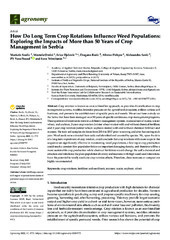Приказ основних података о документу
How Do Long Term Crop Rotations Influence Weed Populations: Exploring the Impacts of More than 50 Years of Crop Management in Serbia
| dc.creator | Šaulić, Marko | |
| dc.creator | Oveisi, Mostafa | |
| dc.creator | Đalović, Ivica | |
| dc.creator | Božić, Dragana | |
| dc.creator | Pishyar, Alireza | |
| dc.creator | Savić, Aleksandra | |
| dc.creator | Prasad, Vara | |
| dc.creator | Vrbničanin, Sava | |
| dc.date.accessioned | 2023-07-14T22:58:59Z | |
| dc.date.available | 2023-07-14T22:58:59Z | |
| dc.date.issued | 2022 | |
| dc.identifier.issn | 2073-4395 | |
| dc.identifier.uri | https://plantarum.izbis.bg.ac.rs/handle/123456789/733 | |
| dc.description.abstract | Crop rotation is known as an eco-friendlier approach, as provides diversification in crop management systems, modifies intensive pressure on the agricultural ecosystem, utilizes various soil horizons, and prevents the establishment of specific pests and weeds. We set out here a study on the farms that have been managed over 50 years of specific continuous crop management programs. The experimental treatments were in a different management system: monoculture of maize, winter wheat, and soybean, 2-year crop rotation (winter wheat–maize) with and without chemical fertilizer, and 3-year crop rotation (winter wheat–soybean–maize) with and without chemical fertilizer and manure. We took soil samples six times from 2014 to 2017 prior to sowing and after harvesting each year. Weed seeds were extracted from soils and identified and counted by species. We, upon the data of a long term experiment of crop rotation, could conclude that crop rotations with more crops in the sequence are significantly effective in maintaining weed populations, a low-input crop production could reach a constant low population below an important damaging density, and therefore will be a more sustainable crop production while chemical fertilizers would change the soil’s chemical and structure and imbalance the plant population diversity and manures with high weed seed infestations have the potential to totally eradicate crop rotation effects, Therefore, clean manures or compost are highly recommended. | sr |
| dc.language.iso | en | sr |
| dc.publisher | MDPI | sr |
| dc.relation | info:eu-repo/grantAgreement/MESTD/inst-2020/200032/RS// | sr |
| dc.relation | info:eu-repo/grantAgreement/MESTD/inst-2020/200116/RS// | sr |
| dc.relation | info:eu-repo/grantAgreement/MESTD/inst-2020/200010/RS// | sr |
| dc.rights | openAccess | sr |
| dc.rights.uri | https://creativecommons.org/licenses/by/4.0/ | |
| dc.source | Agronomy-Basel | sr |
| dc.subject | crop rotations | sr |
| dc.subject | fertilizer | sr |
| dc.subject | soil seed bank | sr |
| dc.subject | manure | sr |
| dc.subject | maize | sr |
| dc.subject | soybean | sr |
| dc.subject | wheat | sr |
| dc.title | How Do Long Term Crop Rotations Influence Weed Populations: Exploring the Impacts of More than 50 Years of Crop Management in Serbia | sr |
| dc.type | article | sr |
| dc.rights.license | BY | sr |
| dc.citation.issue | 8 | |
| dc.citation.rank | M21 | |
| dc.citation.spage | 1772 | |
| dc.citation.volume | 12 | |
| dc.type.version | publishedVersion | sr |
| dc.identifier.doi | 10.3390/agronomy12081772 | |
| dc.identifier.fulltext | http://plantarum.izbis.bg.ac.rs/bitstream/id/2957/bitstream_2957.pdf | |
| dc.identifier.scopus | 2-s2.0-85137336367 | |
| dc.identifier.wos | 00084625340000 |


